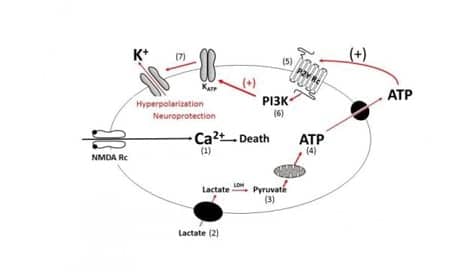
Step-by-step description of how lactate protects neurons against excitotoxicity, according to the release: (1) Excessive glutamate activity triggers a strong influx of calcium (Ca2+) into the neuron through NMDA receptors, which leads to cell death. (2) Lactate is transported into the neuron and (3) converted to pyruvate by the enzyme lactate dehydrogenase (LDH). (4) Pyruvate is then transported into mitochondria by the mitochondrial pyruvate carrier (MPC) where it generates ATP. (5) ATP is then released through pannexins and activates the receptor P2Y, which (6) activates the PI3K pathway. (7) This triggers the opening of potassium channels (K+), which causes the neuron to hyperpolarize, decreasing the neuron’s excitability, and thus protecting it from excitotoxic damage. (Photo courtesy of Pascal Jourdain (EPFL) )
Acute trauma such as stroke or spinal cord injury (SCI) is known to cause nerve cells to receive excessive stimulation—which can damage or kill them. Scientists suggest that lactate can help protect cells from this process, called excitotoxicity.
The receptors that cause this are NMDA receptors, and they interact with the neurotransmitter glutamate. A research team led by Pierre Magistretti from Ecole Polytechnique Fédérale de Lausanne (EPFL) and the King Abdullah University of Science and Technology investigated the effects of glutamate on cultured neurons from the brains of mice. The scientists used a new, noninvasive imaging technique called Digital Holographic Microscopy that can visualize cells structure and dynamics with nanometer-level resolution, explains a media release from EPFL.
In their study, published recently in the Nature journal Scientific Reports, the research team tested the effects of glutamate on the mouse neurons with and without lactate. Their results indicate that glutamate killed 65% of the neurons, but when with lactate, that number dropped to 32%.
To determine how lactate protects neurons, the team used different receptor blockers on the mouse neurons. Per their results, they suggest that lactate triggers the production of ATP, which then binds and activates another type of receptor in the neuron and turns on a complex cascade of defense mechanisms. As a result, the neuron can withstand the onslaught of signals from the NMDA receptor, the release continues.
[Source(s): Ecole Polytechnique Fédérale de Lausanne, Science Daily]





